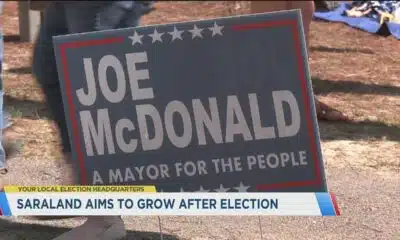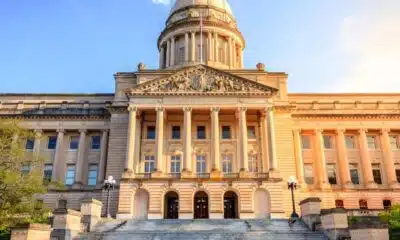News from the South - Texas News Feed
Texas struggles to clean up abandoned oil and gas wells
“Texas has thousands of abandoned oil and gas wells. Who is responsible for cleaning them up?” was first published by The Texas Tribune, a nonprofit, nonpartisan media organization that informs Texans — and engages with them — about public policy, politics, government and statewide issues.
Sign up for The Brief, The Texas Tribune’s daily newsletter that keeps readers up to speed on the most essential Texas news.
LULING — Just six minutes from 5,700-person town’s historic city center, where an old oil museum still nods to the boom days, the ground groans as oil workers pull steel tubing — each piece is longer than a bus — out of a well drilled in 1983 that stopped pumping profits last year. Rain pours on this quiet Texas field, but the crew doesn’t stop their steady pace.
The job has become all too familiar. They’re sealing one of thousands of unplugged orphaned oil and gas wells scattered across the state — abandoned holes left behind by companies that went bankrupt or just walked away. The last company to own this particular well was Geomeg Energy Operating Co., an Aransas Pass-based oil and gas company.
This March project was a snapshot of what plugging a well looks like: part routine, part roulette. Sometimes workers find corroded cement casings, pressurized gas, or unexpected debris that can turn a cleanup into a days- or weeks-long job.
“Even the simplest well can take time,” said Nicholas Harrel, a state managed plugger with the Texas Railroad Commission.
From the air, the wells look like pinpricks across the Texas landscape. But on the ground, they can erupt like geysers, leak methane, and threaten water supplies with toxic chemicals like hydrogen sulfide, benzene and arsenic.
Abandoned oil wells are piling up across Texas, posing a growing environmental threat and saddling taxpayers with cleanup costs that have already reached tens of millions of dollars. In West Texas, at least eight orphaned wells have blown out since late 2024, spewing brine, a salty liquid laden with chemicals from drilling, and toxic gas. One leaked for more than two months before it could be capped. Another has created a 200-foot-wide sinkhole.
“We have more orphan wells coming on than we are plugging,” Railroad Commission Chair Christi Craddick said. “We’ve exceeded our plugging numbers every year, but we still have more orphan wells that keep coming.”
Who’s responsible for cleaning up these wells, and what happens if Texas falls behind? Here’s what to know.
What are orphan wells?
/https://static.texastribune.org/media/files/99aa7769ebb429dc61596b672ecc84a0/2023-01-30_TT_ICN_Sarah_Stogner_Zombie_Wells_Pu.Ying.Huang567.JPG)
Orphan wells are oil, gas, or injection wells with no clear owner — either because the company went bankrupt or disappeared. These wells have been inactive for at least 12 months, meaning the wells do not produce oil or natural gas. Some of them are unplugged.
Texas has nearly 8,900 orphan wells, according to the Railroad Commission’s most recent list. Many are concentrated in oil-rich areas like the Permian Basin, including Reeves, Crockett, and Pecos counties. Pecos has more than 600 of them — the most of any county. Frio County, southwest of San Antonio, follows with close to 500 orphan wells.
Many were plugged with inappropriate materials or using practices that are now obsolete. Older wells — especially those drilled before the 1950s — are more likely to have been abandoned and documentation on who last owned a well can be hard to find.
Who is responsible for plugging orphan wells?
/https://static.texastribune.org/media/files/b5267b34e6133a90e7985b797935f650/RRC%20Hearing%20DS%2014.jpg)
The Railroad Commission of Texas, the state’s oil and gas regulator, is responsible for ensuring that operators plug wells properly.
Once a well stops producing oil or gas, operators are supposed to plug their own wells within 12 months. But when they don’t — in some cases because they went bankrupt — the responsibility can shift to the state.
The agency then evaluates how dangerous the orphan well is — to the environment and public safety — and places the well on a list to be plugged by contractors the agency hires.
The Luling well was added to the Railroad Commission’s list in October 2024 — one of five wells scheduled for plugging in the area.
What are the environmental and health risks of orphan wells?
/https://static.texastribune.org/media/files/fb18e9a5ddecac28a5cfd0613ffc2195/2023-01-30_TT_ICN_Sarah_Stogner_Zombie_Wells_Pu.Ying.Huang382.JPG)
A big concern is air pollution, particularly methane, a powerful greenhouse gas that traps heat in the atmosphere and accelerates climate change. These wells often leak methane, as well as hydrogen sulfide — a toxic colorless gas that smells like rotten eggs. This gas is especially dangerous: it can cause headaches, dizziness and at high concentrations can be fatal.
For years, experts and ranchers have warned about the rising threat that unplugged wells pose to rivers, lakes and groundwater when they leak oil, gas, drilling fluids, and fracking wastewater, also known as “produced water” a toxic mix of salt, hydrocarbons, arsenic, radium and other naturally occurring chemicals. Unplugged wells can create pathways for those chemicals to migrate into groundwater zones.
A spokesperson with the Railroad Commission said they are unaware of any cases of groundwater contamination from orphan wells in Texas.
The risks aren’t just slow-moving — some are explosive. The common industry practice of injecting the massive amounts of fracking wastewater into deep wells can put pressure on underground geological formations. In some cases this pressure has led to increased earthquakes. In other cases, researchers have linked injections to well blowouts — sudden eruptions of water and gas that migrate underground until they hit an old well and burst from the earth.
Blowouts can happen in any well. However, orphan wells and older, plugged wells are less likely to withstand the pressure and blow. Last year in the West Texas town of Toyah, a well erupted and spewed a foul-smelling, hydrogen-sulfide-laced plume that took 19 days to contain. Residents had headaches and wore masks to protect themselves.
Harrel, the Railroad Commission well plugger, said that while the Luling well is a “non-emergency” well, meaning it did not pose an immediate threat, it was still a concern because fluid was rising in the well and could eventually threaten groundwater.
The Luling well is located in a field called Spiller known to have higher hydrogen sulfide levels. A 2024 study found that at least 20 wells in a Luling oilfield were releasing dangerous amounts of hydrogen sulfide gas. Residents report smells as far as Austin — 50 miles away.
What is Texas doing to address orphan wells?
/https://static.texastribune.org/media/files/35ee5bc131aca1a33755c6323b3e0360/0327%20Orphan%20Well%20LW%2010.jpg)
The Railroad Commission operates a State Managed Plugging Program, which is partly funded by the Oil and Gas Regulation and Cleanup Fund that receives bonds, enforcement penalties and permitting fees paid by operators. However, critics say those funds often fall short of actual cleanup costs.
The agency has plugged more than 46,000 wells through the state plugging program since its inception in 1984. The commission said it has budgeted $22.75 million a year to plug 1,000 wells a year. For the past five fiscal years the agency has plugged an average of 1,352 wells per year.
But that money doesn’t go nearly far enough. The cost to plug just two emergency wells this fiscal year hit $9 million, nearly 40% of the state’s entire annual plugging budget, according to Craddick, the agency chair.
To keep up, the commission has increasingly relied on federal support. The Bipartisan Infrastructure Law, passed by the U.S. Congress in 2021, included a $4.7 billion nationwide injection to plug orphan wells on public and private lands. Through that law, Texas received $25 million in 2022 from the U.S. Department of the Interior and another $80 million in early 2024 to plug orphan wells. Combined with state funding, those dollars helped plug over 2,400 wells in 2023–24. However, federal funds are uncertain with changes in administrations.
Meanwhile, plugging costs have also skyrocketed. Just a few years ago, Craddick said it cost around $15,000 to plug a well. Today, the average is closer to $57,000, and that number jumps dramatically for wells with high water flow or hazardous leaks. For example, a blowout near Odessa in late 2023 took more than two months and $2.5 million to contain and plug.
The RRC warned last year that it can no longer sustain the growing cost and scale of the problem and requested an additional $100 million in emergency funding from lawmakers — about 44% of its entire two-year budget — just to keep up with the backlog, tackle urgent sites and cope with rising costs due to inflation. Lawmakers are considering this as part of the overall state budget.
The costs of plugging a well vary by region and are based on how deep the wells are, according to Harell. While the Luling well’s cost has not been finalized, according to the commission’s cost calculation information, the well’s cost will be about $24,000.
The agency prioritizes wells that are actively leaking or pose immediate threats to the environment, groundwater and people. They might be releasing toxic gases like hydrogen sulfide, flooding land with contaminated water, or dangerously pressurized. These wells must be plugged right away, regardless of the cost, according to the commission.
/https://static.texastribune.org/media/files/0a028500f6122a89447978549e8fb6bb/0327%20Orphan%20Well%20LW%2004-2.jpg)
While Craddick noted at a hearing in February the state had 15 priority wells, a commission spokesperson said the number of priority wells fluctuates every day, with typically zero to five wells classified as emergency at any given time.
“If the fluid level in the well, the hydrocarbons and produce water in the well, gets up too close to that freshwater aquifer then it imposes a higher risk to contaminating that groundwater aquifer, so we wanna make sure that we get to those as wells first,” said Travis Baer, an oil and gas division district director at the Railroad Commission.
The Luling well is categorized as a 2H priority well — still high risk but not a full-blown emergency.
How is a well plugged?
At the Luling field, red trucks and equipment surround a rusted pump jack, a mechanical device used to extract oil from an underground well to the surface. One of the trucks has two tanks that hold cement, another carries a cement mixer and a pressure pump.
The process starts with a site assessment: Crews glance at hand-held devices hanging from their neck to test for dangerous gases like hydrogen sulfide and determine the wind direction so they can position themselves upwind. Once the site is secure, three workers wearing hard hats remove equipment inside the 2,000-foot-deep well — steel rods and tubing used to carry oil or gas to the surface.
Almost two hours later, the workers were still pulling out tubing.
Baer, the division district director, said these materials are often salvaged and sold to help offset plugging costs.
Next, they assess the well’s structural condition and measure how high fluids have risen inside.
/https://static.texastribune.org/media/files/86d120a8c3fa3782e74859a6e91f34b4/0327%20Orphan%20Well%20LW%2018.jpg)
Once the well is fully evaluated, crews identify the underground zones that once produced oil or gas — known as perforations. A cast iron bridge plug (mechanical plug) is dropped down the hole, tightly sealed to provide a solid base and prevent fluids from leaking.
“This gives us a permanent bottom, it stops gas migration into our cement plug. So we know we’re getting the best plug on bottom to seal off the perforations in the zone,” said Randy Niedorf, a well plugger with the company Bulldog Oil Well Service.
Then, cement is pumped deep into the well. It flows to the bottom and rises up around the casing, sealing the wellbore and blocking any potential pathways for gas or liquid to migrate. Multiple cement plugs are installed along the well’s depth, including near groundwater layers, to ensure complete isolation of oil and water zones.
The final step is land restoration. Once the well is sealed, crews clean up the site. The Luling well was plugged in two days and all five wells in the area were plugged in about a week.
First round of TribFest speakers announced! Pulitzer Prize-winning columnist Maureen Dowd; U.S. Rep. Tony Gonzales, R-San Antonio; Fort Worth Mayor Mattie Parker; U.S. Sen. Adam Schiff, D-California; and U.S. Rep. Jasmine Crockett, D-Dallas are taking the stage Nov. 13–15 in Austin. Get your tickets today!
This article originally appeared in The Texas Tribune at https://www.texastribune.org/2025/05/08/texas-orphan-wells-explained-railroad-commission-abandoned/.
The Texas Tribune is a member-supported, nonpartisan newsroom informing and engaging Texans on state politics and policy. Learn more at texastribune.org.
The post Texas struggles to clean up abandoned oil and gas wells appeared first on feeds.texastribune.org
Note: The following A.I. based commentary is not part of the original article, reproduced above, but is offered in the hopes that it will promote greater media literacy and critical thinking, by making any potential bias more visible to the reader –Staff Editor.
Political Bias Rating: Center-Left
The content presents an in-depth examination of the environmental and regulatory challenges posed by orphaned oil and gas wells in Texas, highlighting both the risks to public health and the environment and the efforts by the Texas Railroad Commission to address these issues. The tone is factual and emphasizes environmental concerns such as methane emissions, groundwater contamination, and health risks, which aligns with center-left perspectives focused on regulatory responsibility and environmental protection. However, it also includes viewpoints from industry-related officials and acknowledges financial and logistical challenges without overt criticism, maintaining a balanced and nuanced approach typical of a center-left stance rather than a strongly activist or critical position.
News from the South - Texas News Feed
Bevo will not travel to Ohio for the Longhorns’ showdown against the Buckeyes. Here’s why
SUMMARY: The Texas Longhorns begin their season Saturday against Ohio State in Columbus, but their live mascot, Bevo—a 2,100-pound steer—won’t attend. Handler Ricky Brennes explained that traveling to Ohio early in the school year would disrupt students in the Silver Spurs Alumni Association, who manage Bevo, and the long trip isn’t ideal for the steer. The 18-hour drive requires multiple stops for Bevo to stretch and rest in pastures overnight, as he doesn’t stay in the trailer overnight. Bevo is expected to appear at the Longhorns’ next three home games starting September 6.
Read the full article
The post Bevo will not travel to Ohio for the Longhorns' showdown against the Buckeyes. Here's why appeared first on www.kxan.com
News from the South - Texas News Feed
DHS waives environmental laws to build more border wall through wildlife tracts in South Texas
SUMMARY: The Department of Homeland Security, led by Secretary Kristi Noem, is waiving numerous environmental and health regulations to expedite construction of five miles of border wall through wildlife refuges in South Texas’s Rio Grande Valley. These waivers affect protected areas within the Lower Rio Grande Valley National Wildlife Refuge, threatening endangered species and habitats. Environmentalists criticize the move, highlighting the violation of 31 laws, including the Endangered Species Act and Clean Water Act. Despite historically low border apprehensions, DHS insists the construction is vital for security. Critics argue the wall disrupts wildlife corridors and targets federal lands to avoid legal hurdles, causing significant ecological harm.
Read the full article
The post DHS waives environmental laws to build more border wall through wildlife tracts in South Texas appeared first on www.kxan.com
News from the South - Texas News Feed
About 750 new laws will go into effect in Texas on Sept. 1
“More than 800 new laws will go into effect in Texas on Sept. 1. Here are some of the significant ones.” was first published by The Texas Tribune, a nonprofit, nonpartisan media organization that informs Texans — and engages with them — about public policy, politics, government and statewide issues.
Sign up for The Brief, The Texas Tribune’s daily newsletter that keeps readers up to speed on the most essential Texas news.
More than 800 new laws are about to take effect in Texas, and they are set to bring sweeping changes to the state’s education systems, water infrastructure and more.
Gov. Greg Abbott signed 1,155 bills that came out of the regular legislative session, including over 200 laws that went into effect immediately such as the school cellphone ban, the abortion ban clarification, property tax cut and increased oversight over the energy grid. Meanwhile, some won’t activate until next year or until voters approve constitutional amendments in November, such as stricter bail policies and a $3 billion dementia research fund. In addition, there are 140 bills that the governor didn’t take action on, including 34 that took effect immediately.
Most, however, will start on Sept. 1, the traditional date for laws passed during the regular session. Here are some notable measures that will soon take effect:
Senate Bill 1 lays out the state’s new $338 billion two-year spending plan, with over 70% of the budget being reserved for education and health and human services. Some notable parts include spending to maintain and provide property tax cuts, a new school voucher program, additional funding for public schools, as well as investments in the state’s energy, water and broadband infrastructure.
The plan also initially included a $60 million measure that would have let Texas enter a federal summer lunch program for low-income kids, but Abbott vetoed it due to “significant uncertainty regarding federal matching rates for this and other similar programs.”
Senate Bill 2 will create one of the country’s largest school voucher programs, allowing parents to pay for their children’s accredited private school tuition or other education-related expenses with public tax dollars. In most cases, each child will receive just over $10,000 per year, though students with disabilities could receive up to $30,000 in additional funding. Wealthier families with children already in private schools could also participate.
Texas can spend up to $1 billion during its upcoming two-year budget cycle, though the program’s cost could rise significantly afterwards.
The law’s passage followed years of fighting between GOP lawmakers, who framed the issue as providing school choice to parents, and Democrats and rural Republicans who said vouchers would harm public schools. Abbott threw his weight behind the effort to elect more pro-voucher Republicans and succeeded last year. SB 2 takes effect on Sept. 1, but the voucher program itself isn’t expected to launch until the 2026-27 school year.
House Bill 2 will provide about $8.5 billion in new money to public schools, as districts across the state tackle long-running challenges following years of stagnant funding. From this pot, more than $4 billion will go toward raising educator’s pay. The additional dollars will also be used for educator preparation, special education, safety requirements and early childhood learning. A significant part of the law activated immediately, while another big chunk will take effect on Sept. 1. Some will roll out in future years.
Senate Bill 10 will require the visible display of the Ten Commandments on donated posters that are at least 16 by 20 inches in public school classrooms, which are attended by around 5.5 million students in Texas. While supporters said Christian teachings are important to understanding American history, critics said this law undermines the separation of church and state. Such laws have already faced legal challenges in Texas and other states. They include an Aug. 20 ruling from U.S. District Judge Fred Biery, which temporarily blocks the measure from taking effect for nearly a dozen school districts including Austin, Houston and Plano.
“This issue is likely to get to the United States Supreme Court,” Biery said prior to the case’s opening statements in San Antonio. Texas is expected to appeal his ruling.
Senate Bill 12 will extend the ban on diversity, equity and inclusion policies to K-12 schools. In particular, it will prohibit school districts from factoring race, ethnicity, gender identity or sexual orientation into hiring decisions. It will also bar schools from offering instructions, programs and guidance that focus on sexual orientation or gender identity, including sponsoring student clubs such as Gender and Sexuality Alliance. The law’s backers said the legislation gives parents more control over their children’s education, while critics said it targets and censors marginalized groups, such as LGBTQ students. Some civil rights groups including the ACLU of Texas have vowed to fight the law in court.
Senate Bill 13 will give parents and school boards more power over what students can access in public school libraries. These boards can also delegate this oversight process if 50 parents in the same district sign a petition for the creation of a local school advisory council. Supporters said the law will protect students from inappropriate content and give parents more control over what their children consume, while critics said it will lead to increased censorship of certain topics such as gender and race. Texas was already among the top states for book bans in recent years, according to PEN America.
Senate Bill 37 will give politically appointed regents more power over public universities, including by granting them more say over the hiring of administrators, as well as over some responsibilities that were traditionally held by faculty members. It will also create an office that can investigate universities for failures to comply with state laws, such as regarding DEI initiatives. The law’s backers said it is needed to tackle what they consider to be liberal bias in universities and better align them with Texas’ workforce demands. Critics, however, said the law will threaten academic freedom and undermine research.
House Bill 33, authored by Republican state Rep. Don McLaughlin who was mayor during the Uvalde school shooting, will require law enforcement agencies across Texas to establish crisis response policies. Among several changes, the law will compel school districts and local law enforcement to meet annually in order to assess their emergency operations plans, resources and capabilities. It will mandate law enforcement agencies and emergency medical service providers to complete training programs on how to respond to active shooters at primary and secondary schools. And following an actual shooting, these responders will also have to file a report detailing and evaluating their actions within several months to facilitate faster public access to information.
Senate Bill 7 will create a framework for funding water projects through the Texas Water Development Board and providing oversight over them, amid a broad effort to tackle the state’s looming water crisis. Certain sections of the law would take effect in September 2027, if voters approve the constitutional amendment outlined by House Joint Resolution 7 in November. This ballot measure, if accepted, would allocate $1 billion each year from the state’s sales and use tax revenue to the Texas Water Fund between 2027 and 2047.
Senate Bill 15, which received mixed support from both parties, will allow for certain single-family homes to be built on smaller lots. In particular, the law will ban big cities from requiring these homes to sit on more than 3,000 square feet of land, if they are being constructed in a new subdivision that is at least five acres in size. This is a drop from the 5,000 to 7,500 square feet of land that are commonly required in Texas’ largest cities — except for Houston — according to a Texas Tribune analysis. While some lawmakers were wary about interfering in local control over the issue, supporters said the change will allow cities to build more housing and keep costs down.
Senate Bill 17 will ban governments, companies and individuals who legally reside in China, North Korea, Russia and Iran from owning land and properties in Texas. The governor also has the authority to add countries or entities to the list. The prohibition doesn’t apply to U.S. citizens or permanent residents. The law’s backers said this is about protecting resources and national security from hostile nations, while critics said SB 17 is discriminatory and will lead to racial profiling.
Senate Bill 33 will ban cities or counties from using their money to support residents seeking abortions outside Texas. The law followed Austin City Council’s appropriation of $400,000 last year to help such individuals, prompting lawsuits from Attorney General Ken Paxton and a former council member. San Antonio City Council also allocated $500,000 for a reproductive justice fund in 2023, though it ended up not being used for abortion-related initiatives following a private lawsuit and much debate. It then approved $100,000 in April for abortion-related travel, which was temporarily blocked after Paxton sued.
House Bill 46 will expand the state’s medical marijuana program to include patients with chronic pain, traumatic brain injury and Crohn’s disease. Physicians will also be able to prescribe inhalation via vaporized and aerosol products, such as vapes. This expansion will take effect while the Texas Legislature contemplates whether to regulate or ban hemp-derived THC products.
House Bill 229 will define man and woman based on biological reproductive systems and apply that definition across the state code. Government entities collecting vital statistics information will also have to use it. The law’s backers said this is needed to protect women’s rights and align with executive orders declaring that there are only two sexes. Critics said the law erases trans people from state records in Texas, home to one of the country’s largest trans communities.
Senate Bill 835, titled “Trey’s Law,” will ban and void the use of nondisclosure agreements in sexual assault and human trafficking cases. The law’s name honors Trey Carlock, who signed an NDA after being abused as a child by a camp counselor. He died by suicide in 2019. His sister, Elizabeth Carlock Phillips, testified in support of the legislation.
Disclosure: ACLU Texas has been a financial supporter of The Texas Tribune, a nonprofit, nonpartisan news organization that is funded in part by donations from members, foundations and corporate sponsors. Financial supporters play no role in the Tribune’s journalism. Find a complete list of them here.
More all-star speakers confirmed for The Texas Tribune Festival, Nov. 13–15! This year’s lineup just got even more exciting with the addition of State Rep. Caroline Fairly, R-Amarillo; former United States Attorney General Eric Holder; Abby Phillip, anchor of “CNN NewsNight”; Aaron Reitz, 2026 Republican candidate for Texas Attorney General; and State Rep. James Talarico, D-Austin. Get your tickets today!
TribFest 2025 is presented by JPMorganChase.
The story has been updated to correct the number of bills from the regular legislative session that will go into effect on Sept. 1. There are more than 800 bills, not 750.
This article originally appeared in The Texas Tribune at https://www.texastribune.org/2025/08/28/texas-new-laws-sept-1/.
The Texas Tribune is a member-supported, nonpartisan newsroom informing and engaging Texans on state politics and policy. Learn more at texastribune.org.
The post About 750 new laws will go into effect in Texas on Sept. 1 appeared first on feeds.texastribune.org
Note: The following A.I. based commentary is not part of the original article, reproduced above, but is offered in the hopes that it will promote greater media literacy and critical thinking, by making any potential bias more visible to the reader –Staff Editor.
Political Bias Rating: Center-Right
The content presents a detailed overview of recent Texas legislation, highlighting laws typically supported by conservative and Republican lawmakers, such as school voucher programs, restrictions on diversity and inclusion policies, and measures emphasizing parental control in education. While it also notes some bipartisan support and includes perspectives from critics, the overall framing aligns more closely with center-right viewpoints, reflecting Texas’ current political climate and Republican governance.
-
News from the South - Texas News Feed5 days ago
DEA agents uncover 'torture chamber,' buried drugs and bones at Kentucky home
-
News from the South - Missouri News Feed7 days ago
Missouri settles lawsuit over prison isolation policies for people with HIV
-
News from the South - Texas News Feed3 days ago
Racism Wrapped in Rural Warmth
-
Local News6 days ago
Florida must stop expanding ‘Alligator Alcatraz’ immigration center, judge says
-
The Center Square6 days ago
Georgia ICE arrests up 367 percent from 2021, making for ‘safer streets, open jobs | Georgia
-
News from the South - Kentucky News Feed6 days ago
Quintissa Peake, ‘sickle cell warrior’ and champion for blood donation, dies at 44
-
News from the South - Oklahoma News Feed6 days ago
Tom Cole’s Powerful Spot on the Appropriations Committee Is Motivating Him to Stay in Congress
-
Local News7 days ago
Fifth-annual Citizen’s Police Academy kicks off in Biloxi










































